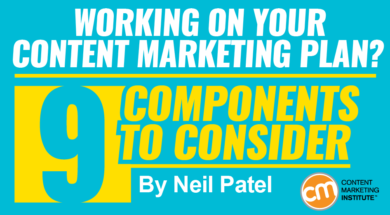One article per day is the minimum goal you want to meet, in addition to at least three posts on each social media platform. The internal focus ultimately is to drive sales, but content marketing isn’t salesy content (I’ll come back to this point later). Content should be focused on creating a brand image and telling a story. Evergreen content is easier to write for long-term editorial calendars, but topical content can drive spikes in traffic. With a documented content marketing strategy, in a week you can easily create a three-month plan and plan time to create one or two more quarters in those three months. You can link multiple social media accounts within your content management system to automatically publicize your content as soon as it’s published. Content marketing is not the same as marketing content. That’s content marketing. By creating informative content that’s strategically placed throughout the web, businesses can generate warm leads and increase sales. Make CMI’s free daily or weekly newsletter a key component of your content marketing training.

Building an overall brand story is essential to effective marketing, and doing so online can be achieved by mixing a little business operations with journalistic procedures.
Documenting a content marketing plan can be simple, and it must be done. Here are nine essential components to consider.
1. Set a tiered goal
Every successful business plan starts with a set of tiered goals. Set quantifiable annual, quarterly, and monthly progress goals so everyone knows what to aim for. One article per day is the minimum goal you want to meet, in addition to at least three posts on each social media platform. These posts are meant to build on the story of the daily article – think of them as the special features on a Blu-ray disc.
When the article is automatically promoted on each social media channel, three posts of conversational subject matter are necessary to keep the social media channels feeling fresh and active.
Don’t worry too much about how much direct traffic you get from each individual post, but do include daily, monthly, and annual traffic in your content marketing and social media reports.
2. Quantify ROI
The only way to know something isn’t working is to quantify it. Lead generation and sales should increase by a certain percentage by the end of the year. Any increases to the content marketing budget should reflect an appropriate lead generation and sales increase by the end of that fiscal year.
It’s important in marketing to track quality and production numbers for operational purposes. You wouldn’t print 1,000 coupons without accounting for usage. Results for every published post should be documented.
Documented production and quality numbers allow marketing managers to be proactive instead of reactive by identifying weak links in the system when ramping up to 10 or even 100 posts per day.
3. Determine content purpose
Before you create content, you need to identify the reason for the content. The internal focus ultimately is to drive sales, but content marketing isn’t salesy content (I’ll come back to this point later).
Content should be focused on creating a brand image and telling a story. How you tell your story is your choice, which centers on two types of content – evergreen and topical.
Evergreen content is a general truth or comment of the human condition like encyclopedic or academic knowledge – it’s a topic that is always (or almost always) valid and current no matter the year. Topical or time-related content is about current events like news, reviews, and gossip. For example, “corrupt politics” would be an evergreen topic, while “2017 political candidates are corrupt” would be topical content.
Evergreen content is easier to write for long-term editorial calendars, but topical content can drive spikes in traffic. The problem is the interest in timely content fades as the event becomes less current.
Consider implementing an RSS feed to curate current event topics in a sidebar (or on social media) while featuring evergreen content on your website and app.
4. Create an editorial calendar
To keep things running smoothly, it’s important to…

COMMENTS